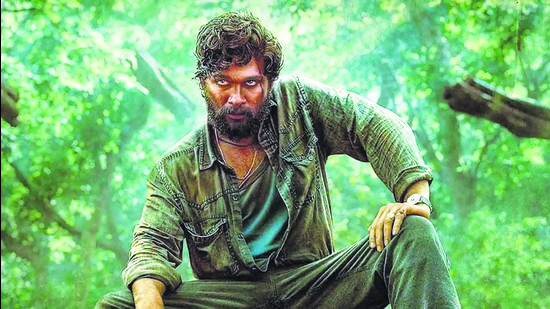Hero worship gone wrong: Deepanjana Pal writes on Pushpa 2
Isn’t it odd that the most successful film of 2024 is built around a man who ravages nature, and appears to care only for himself?
At one point in the first half of Pushpa 2: The Rule, the titular hero (played by Allu Arjun) throws down a challenge to his nemesis, the police officer Bhanwar Singh Shekhawat (Fahadh Faasil).

Pushpa promises to whisk an enormous heap of red sanders logs out from under the noses of patrolling cops, just to snub the cop. In this battle of egos between two insecure and maniacal men, red sandalwood becomes the pawn.
Soon enough, we see thousands of logs piled up to create a tower as tall as a multi-storey building. Pushpa stands atop the pile, a vision of smug swagger. It’s supposed to be a hero moment, but to me it was reminiscent of Saruman from The Lord of the Rings, surveying with satisfaction the land he had laid waste.
Except, with Saruman, the stare was meant to be a sign of evil. Here, we are meant to revel in Pushpa’s omnipotence. The thrilling way he is later able to best Shekhawat is meant to establish him as a modern lord of the forest who controls everything from herds of wild elephants to the water level of a river.
The film even celebrates how red sandalwood is refashioned into domestic items (a cart, a sofa), as though the trees have no purpose other than to cater to human whims. Drone shots show a thickly forested landscape, as though the rapacious logging leaves no scars.
At no point in the film’s 200-minute runtime does Pushpa show any remorse for the devastation. Instead, he is carelessly arrogant towards the natural world in which his power is literally rooted.
For the record, red sandalwood is a slow-growing, fire-hardy, drought-resistant, endangered tree species that takes between 25 and 40 years to mature.
2024 is the hottest year on record. We are eyeballs-deep in a climate crisis. How is this the hero of the most successful Indian film of the year?
The sandalwood isn’t the only victim, incidentally.
Soon enough, despite a few well-imagined sequences, the film devolves into a celebration of an action hero who reflects both the anxieties and fantasies of contemporary Indian masculinity. Armed with a chip on his shoulder and delusions of victimhood, he rages his way through the extended runtime, despite having no reason to rage.
From the beginning of the film, he is clearly more powerful (and commands more respect) than Shekhawat and the other villains. These circumstances, a change from Part 1, don’t seem to have improved either his mood or conditions in Chittoor, Andhra Pradesh (incidentally a real-world hub of red-sanders smuggling).
Social hierarchies remain fixed in place. Women are still defined by the men in their lives. Workers are the property of their employers. Trans identity is either vilified or ridiculed. Machismo is the only social currency with any value.
The only difference is that Pushpa, once in the lowest strata, now occupies the peak, as a benevolent, blinged-out patriarch.
And the world has been bent out of shape in order to make possible this rise of the masculine underdog.
Those who work for Pushpa are happy to be his subjects. To his wife, he’s a walking-talking aphrodisiac whom she calls “Saami (Lord or Master)”.
One could argue that amid all this, the issue of the red sanders is a minor one, but it is a telling detail. Pushpa 2 is the ultimate fantasy of male domination. And in this fantasy, all else — narrative logic, female characters and, yes, even the trees — exists to serve the alpha hero, and is bent to his will.
Never mind what that means for the world he inhabits. So long as Pushpa can rule.
(To reach Deepanjana Pal with feedback, write to @dpanjana on Instagram)
All Access.
One Subscription.
Get 360° coverage—from daily headlines
to 100 year archives.



HT App & Website







